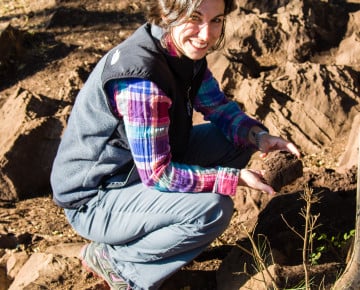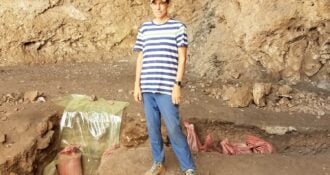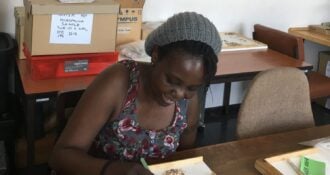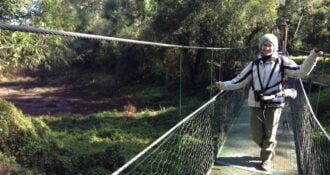Julie Lesnik was awarded a Leakey Foundation Research Grant during our fall 2015 cycle for her project entitled “An evaluation of termite-associated hydrocarbon signatures as an influence on prey selectivity and an ecological signal for chimpanzees and Olduvai hominins.” Her co-PIs are Clayton Magill and Robert O’Malley.

Julie Lesnik investigating a termite nest at the South African fossil hominid site of Malapa known for its 1.9 million year old fossils of Australopithecus sediba.
Termites are a diverse family of insects that thrive in a wide variety of African environments. Today, many great apes and humans alike consume termites across southern and East Africa. In spite of the dietary significance of termites to apes and humans and the consistent link between tool-use and termite foraging in many great apes, insect foods are often overlooked in models of hominin diet and behavior. Therefore, we seek to address questions about the role of termites in the diet of Pleistocene hominins in southern and East Africa via strategic chemical analyses.
Interestingly, contemporary great apes and humans throughout Africa both show a notable consumption preference for termites of the subfamily Macrotermitinae, particularly species of the genera Macrotermes and Pseudacanthotermes. One of our goals is to identify underlying chemical signatures that affect termite preference by comparing preferred termite prey to termites that are never, or rarely, selected as food.
Additionally, recent excavations at Olduvai Gorge have uncovered several mounded features that contain remarkable similarities to present-day nests belonging to the termite genus Macrotermes. We will be investigating whether the chemical signatures of modern termites are reflected in their nests, and then extend this research to the Olduvai features with the aim of confirming the presence of Macrotermes termites on the 1.845 million year old hominin landscape.






Comments 0